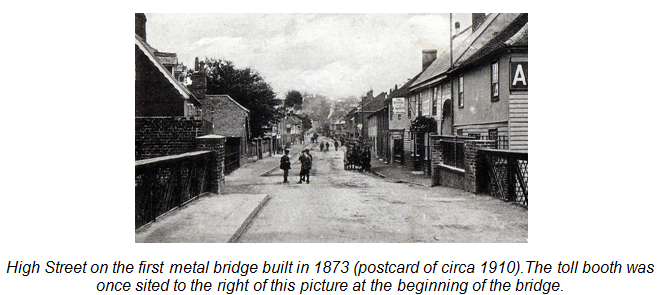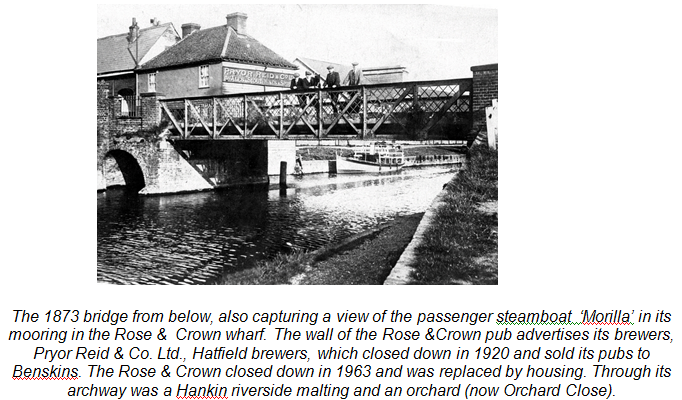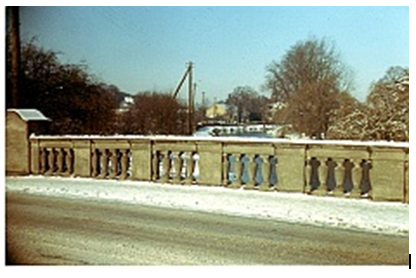STANSTEAD BRIDGE – A BRIEF HISTORY
by Ron Dale
The first known bridge over the river Lea was built in the 12th century, circa
1100, to join up the parishes of Thele (now St. Margarets) and Stanstead (before
it became Stanstead Abbotts). We do not know if the Romans built bridges here, but
they were in the area for quite a long time. The naming of the 12th century tiled
bridge is intriguing as in 1100 there was no manufacture of tiles in our area, but
there certainly would have been in Roman times. In early documents which were always
in Latin, the bridge (and the area around it) was called either pontem tegule (tiled
bridge) or pontis de Thele (Thele bridge). For a deeper discussion into these two
names, see elsewhere on this web-
In 1247/48 we learn from ancient records (cartae antiq.m.22/23, RR7) that the men of London had built a granary at the Tiled Bridge (ad pontem tegule) where they stored their corn which they carried up to London in their own boats and not in the King’s boats. This proves that the Tiled Bridge was on the main river and the granary would have most likely have been roughly where the Riverside Gardens are today, downstream of the bridge. It was a toll bridge from the beginning. In fact it is highly likely that the word Thele was derived from the Latin word for tax or toll, thelonium, but this is only my opinion. Others claim it meant island.
The tolls from Thele Bridge (and others) were paid to the Warden of Hertford Castle and in 1299 this was the Earl of Pembroke (our traditional overlord), appointed there in 1250. Because the lord of Thele manor, Roger de Burun, had generously donated a tenement and a piece of land on the riverside near the bridge, in 1299, the abbey of St. Albans attempted to claim the toll money, but it was refused and they were told that the tolls had always been paid to Hertford Castle and its governor and would continue to be paid to him. It is my opinion this piece of land was the site known today as Pitansry Meadow (see elsewhere on this site). By 1331 Aymer de Valence, Earl of Pembroke of Hertford Castle, died and the tolls of both Thele Bridge and Ware Bridge were granted to John Lucas of Ware. The tolls were afterwards granted back to John of Gaunt who was now at Hertford Castle, appointed in 1360. The tolls then descended with Hertford Castle governors, except for occasional leases to 1630, when Hertford, the castle and the tolls were alienated from the Crown.
The Bridge of Thele then passed to William Cecil, Earl of Salisbury. Throughout
the centuries Thele Bridge was a wooden bridge and there were probably very many
of them over 700 years until the first metal one was built in 1873. We have no record
of these bridges except a brief reference to a new bridge in the 16th century by
historian, Leland, referring to the routing of the Vikings by King Alfred on their
raid to Ware in the 9th century which, according to the Anglo-
The modern bridge, built in 1925 and still taking the strain.
(Photo: Charles Lovick)
The ornate concrete bridge illustrated above is the current bridge, built in 1925
to cope with the increase in motorised traffic and now, although the bridge no
longer carries the A414 main road into Essex and beyond, the it still bears a heavy
daily two-
Ron Dale, April, 2017


